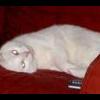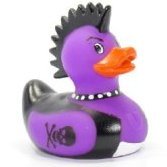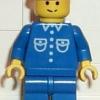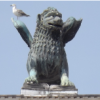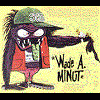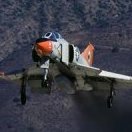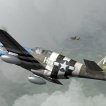-
Posts
64 -
Joined
-
Last visited
About Pilot Officer Prune
- Birthday 31/10/1946
Contact Methods
-
Website URL
http://www.lincolnmodelclub.co.uk
-
ICQ
0
Profile Information
-
Gender
Male
-
Location
Lincoln, UK
Recent Profile Visitors
5,016 profile views
Pilot Officer Prune's Achievements

New Member (2/9)
287
Reputation
-
Interest registered for 1/48 please, and possibly 1/72 as well!
-
Supermarine Spitfire FR Mk.XVIII, TZ233, 208 Squadron., RAF, Fayid, Egypt, 1948/49 The aeroplane is painted in the short-lived ‘Post-War Desert Scheme’ of Dark Earth and Light Slate Grey over Medium Sea Grey. Anecdotally, the scheme was rushed into service to reduce confusion and aid identification during the Israeli War of Independence, when the Israelis, the Egyptians and the British were all flying Spitfires! 1/48 scale Airfix Spitfire FR.XIV kit, modified to Mk.XVIII by leaving the wingtips on, using the large rudder, modifying the wing panel lines to remove all traces of the outer gun bays, and cutting the under-fuselage camera ports. I also added an Ultracast seat, and a Gyroscopic gunsight, courtesy of an Eduard Spitfire kit. Decals from Xtradecal sheet 48-127, paints by Colourcoats, applied with a Sparmax Max4 airbrush.
- 5 replies
-
- 21
-

-

-
Gloster Meteor FR.9, WX978, 2 (AC) Sqn, RAF, Gütersloh, May 1953. 1/48 Airfix kit (A09188), assembled SFTB, paints by Colourcoats and Humbrol. Onwards and Upwards!
- 6 replies
-
- 18
-

-
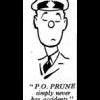
1/48 Spitfire LF Mk.Vc
Pilot Officer Prune replied to Pilot Officer Prune's topic in Ready for Inspection - Aircraft
Not really. The 'trick' seems to be to leave the final cementing of the cockpit interior - and particularly the IP - until you have wiggled/coerced/hammered the tank cover into place. -
Spitfire LF Mk.Vc Trop., JK345 336 (Greek) Sqn, RAF, Greece 1944. Airfix Mk.Vb with Alley Cat Mk.Vc conversion, markings from Xtradecal #48150, paint from Tamiya and Colourcoats
- 6 replies
-
- 23
-

-
In the Programme above, it's a 20 second clip from 14'30"-ish.
-
Hannants have black 8" serials on Xtradecal X32021 They also have Sky codes on Xtradecal X32023 (24" codes) and Xtradecal X32024 (30" codes) Should you be in need of MSG codes, they are also available. Usual disclaimers - I have no connection with Hannants other than as a satisfied customer. HTH Ian
-

Eduard wet transfers for their 1/48 Fw-190
Pilot Officer Prune replied to Kahunaminor's topic in Aircraft WWII
See here for details : http://hgwmodels.cz/en/content/18-wet-transfers -

Building the Yak 28 Firebar ( Bobcat )- vague instructions
Pilot Officer Prune replied to neilh's topic in Aircraft Cold War
Are you sure it's a Brewer? As far as I know, only the Firebar has been released thus far. I confess that I omitted the parts you mention from my Firebar build, and I installed the undercarriage legs as the instructions suggested, although I left off the wheels until much later. Ian -

Airfix Buccaneer S.Mk.2, 1/48
Pilot Officer Prune replied to pigsty's topic in Ready for Inspection - Aircraft
Thanks for the inspiration, Sean. I'm in the clamping/gluing,scraping/filling/sanding cycle with mine at the moment. You've given me strength to carry on! -
I have always been fascinated by those strange Soviet aircraft, that appeared only as blurred images in the days of my youth. I have recently been intrigued by Spencer Pollard's explanation of how he approaches natural metal finishes. I therefore decided to 'give it a go'. This is Trumpeter's 1/48th Sukhoi Su-11 "Fishpot". It's OOB, except for some stencilling on the 'Anab' missiles, masking tape belts, and a bit of 'creative gizmology' under the canopy. It took eight days, start to finish, devoting a couple of hours a day. Is it accurate? I don 't know - and, to be honest, I don't really care. It looks like I hoped it would. TLAR! Enjoy!
- 6 replies
-
- 17
-

-
This is the Tan Model kit, built strictly OOB - no aftermarket, no scratch-building, no detailing. Heck, I even used the kit decals! All in all, a much more pleasant experience than I had anticipated. Such minor glitches as I encountered were of my doing - the kit is lovely. Enjoy . . . Keep bashing the plastic!
- 6 replies
-
- 31
-

-

Post war 10" 1/72 scale RAF/RN Serial decals query
Pilot Officer Prune replied to perdu's topic in Aircraft Cold War
Just a tip - if you,re using Word, or any other DTP/WP program, each 'point' in print size equates to 1/72 of an inch. Thus, 10 pt lettering will give you 10" serials in 1/72 scale (and 15 pt will give you 10" serials in 1/48). Suitable fonts are downloadable here. HTH -
It must be a Lincolnshire thing! Mine also arrived this morning, hassle- and extra charge- free, and looking every bit as good as I hoped. I predict an imminent orgy of Alclad!
-
In 1946, the Air Ministry and the Admiralty issued the specifications F.44/46 and N.40/46 for a twin-engined, two-seat long range fighter. De Havilland responded with their de Havilland 110, and Gloster with their GA.5. The RAF expressed an interest in the de Havilland project, and a number of prototypes were ordered. The Navy rejected both proposals, and opted for an enhanced Sea Venom. Gloster lobbied successfully, and prototypes of their tailed delta design were also ordered, even though the de Havilland design seemed more promising. By 1951, the dH 110 was well into its test programme, regularly flying supersonically, while the GA.5 (Javelin) was plagued by flutter and other aerodynamic problems. Then, at the Farnborough Air Show on 6th September 1952, the dH 110 prototype WG236 broke up in transonic flight, with the engines and forward fuselage ploughing into the crowd, killing the crew and 29 spectators, and severely injuring more than 60 others. The RAF switched its attentions to the Javelin, and four years later, the Navy accepted a navalised dH 110 as the Sea Vixen. But what if . . . If John Derry had flown his display without incident, the Air Ministry’s choice may well have alighted on the de Havilland design. It was aerodynamically superior to the Javelin, which was thick-winged and draggy, with inadequate pitch control and engines buried so deeply in the fuselage that power losses in the intakes and exhausts emasculated them. The Vixen, on the other hand, was aerodynamically cleaner, with a relatively thin wing, and offered potential advantages in range, speed and acceleration. It was also cleared for use of the Firestreak and Red Top Missile much earlier than was the Javelin. If the RAF had gone with the Vixen, by 1970 they might have ended up with this: de Havilland Vixen F(AW).5, 11 Sqn, RAF, Geilenkirchen, 1970. Enjoy! Ian
- 16 replies
-
- 38
-



